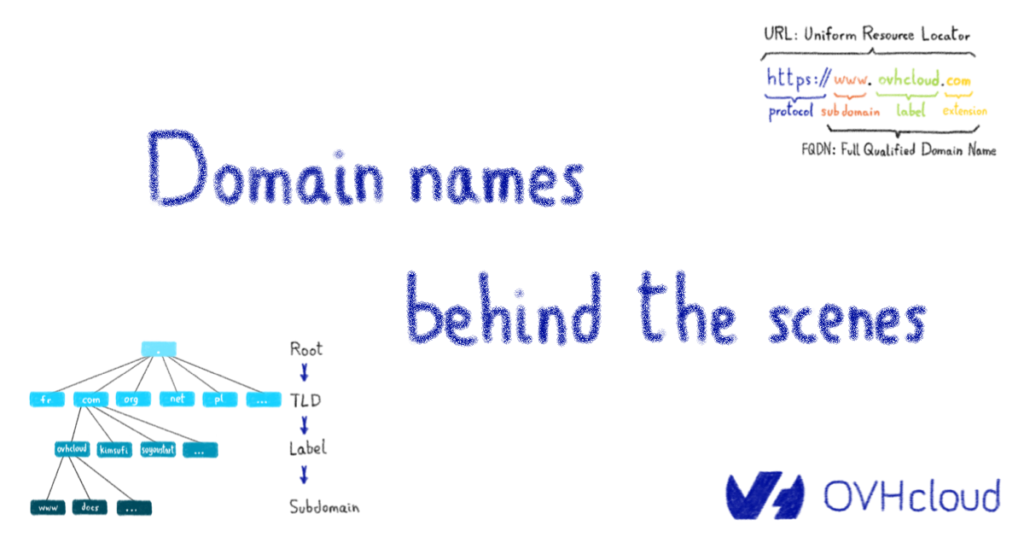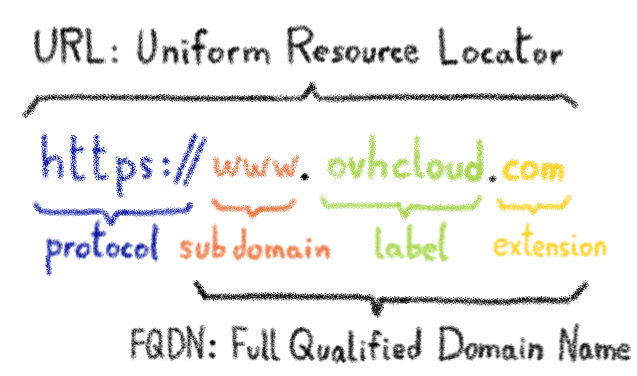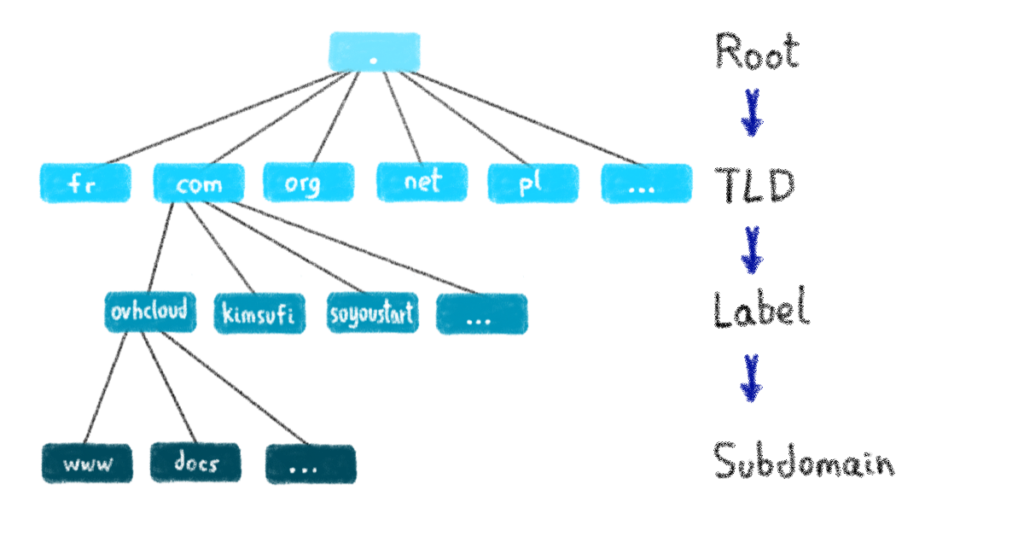We are starting a series of 3 articles introducing the domain name business through the prism of OVHcloud. As simple as it may seem, the universe of domain names is actually quite complex and after reading these articles, you will be more familiar with vocabulary, actors, lifecycle, and so on…

What is a domain name?
A domain name is a unique human readable identification string that is rented by an individual, a company or an organization on the internet, in order to simplify memorization of elements through domain name servers. For example, domain names can be used to remember an IP address for a web site, an SPF entry for mailing, or a MX mailbox, etc…
The main goal of a domain name is to allow to connect to an internet server by using an easy-to-remember, explicit, and persistent name, instead of its IP address. For example, ovhcloud.com is easier to remember than 54.39.46.56.

DNS, or ‘Domain Name System’ are services whose goal is to translate a domain name to an ip address. It’s a hierarchical system. In this article series, we won’t talk about DNS, and its sophisticated mechanisms.
We will only talk about domain name. If you are interested in DNS, check our blog regularly. But it’s necessary to understand that domain names are organized in subordinate levels of the DNS root domain, which is nameless. The domain root is the top of hierarchical system.

Below this top level, we find global TLDs (Top Level Domain) like .com, .org, .net, and so on, as well as domain names representing countries called ccTLDs (like .fr for France or .uk for United Kingdom). Then, we can find a label which is the differentiating name of the site such as a brand or an organization, like ovhcloud.
Finally, you can find sub-domains (sub entities of the domain) that can redirect to another ip address like www, docs, or static to have a particular domain for static files on a internet website.
We will talk about different TLDs further in this article.
Basic notions
ICANN, Registry, Registry backend, Registrar, Registrant: who is who?
To better understand the Domain Names Industry, we must define the various stakeholders.
First, the registry is the entity in charge of the management of the top-level domain names (TLDs). They create TLDs (also called extensions), their relevant rules and work with registrars to sell domains name to customers. As an example, .com is managed by Verisign and .fr by Afnic. Most of the time the registry is a private company, but it may be an association in relation with a government, particularly for ccTLDs.
On another end, there is also the registry backend. This organization manages the top-level domain names from a technical perspective. Sometimes, the registry and the registry backend are different organizations but most of the time they are the same.
A registrar is an accredited organization, like OVHcloud, which is able to sell domain names to the public with the panel of TLDs provided by registries. As a registrar, we purchase a fixed-term license, which can be renewed indefinitely. Thus, we make this license available to our customers, the registrants, who buy their domain name. This way, our work is very similar to that of a real estate agency. Customers don’t rent a house for a year, but a domain name.
In addition, at OVHcloud we combine our registrar role with the registry one for the .ovh that we manage. However, for this special case we are not the registry backend since we use the services of Afnic, like a lot of french TLDs.
The owner of the domain name is called the registrant. It can be a natural person or a company. As a registrant, you can manage your domain name’s settings through the registrar: at OVHcloud, you can do so on the Control Panel. Then the registrar forwards the changes made by the registrant to the registry: the registry’s database can be updated. Indeed, the registrar acts as a link between the registrants, who are its direct customers, and the registry. In this way, the registrant is always in relation with the registrar but never with the registry.
The Internet Corporation for Assigned Names and Numbers, or ICANN, oversees the entire domain name system. It is a non-profit organization responsible for coordinating domain names, IP addresses and DNS, formed in 1998. ICANN brings together people from around the world who work to maintain the security, stability and interoperability of the Internet.
Thus, it promotes competition and develops policies about DNS (Domain Name System) use. This way, it makes sure IP addresses and domains are unique by coordinating these across the world, so we can avoid duplicates. ICANN’s role is to oversee the “universal resolvability”. This means that wherever you are on the network – and hence the world – that you receive the same results when you access the network.
It also accredits Registrars to let us sell domains to the Registrants. In a certain way, ICANN is dedicated to preserving stability on the Internet. However, ICANN doesn’t control content on the Internet but through its role ICANN has an important impact on the expansion and evolution of the Internet.
The different types of TLDs
There are two types of TLDs: gTLD and ccTLD (Generic Top-Level Domains and Country-Code Top-Level Domains).
gTLDs are transnational extensions. The most known is obviously .com, but we also find .org .net .info. The .ovh extension is also a gTLD. Most of the time and unlike ccTLDs, gTLDs do not correspond to a geographical area, but rather to a thematic field. In general, a .tech refers to a website focused on the tech and geek universe while an .org (for organization) generally refers to non-profit organizations. Note that unlike ccTLDs, gTLDs are always composed of a minimum of 3 letters. A ccTLD is composed of 2 letters.
It is important to distinguish the gTLDs called “sponsored” from those that are not. To register a domain name with a sponsored TLD, some conditions must be met. They are enacted by sponsors: they can be private companies or organizations. For example, .gouv.fr is an extension sponsored by the French government and cannot be used by anyone. On the contrary, non-sponsored TLDs are regulated and controlled centrally by ICANN (Internet Corporation for Assigned Names and Numbers). Thus, not being subject to conditions like sponsored TLDs, a domain name with a non-sponsored gTLD can be registered by individuals, companies, organizations, associations, etc.
The ccTLDs, as for them, are logically linked to countries or regions of the World. We find .fr for France, and .be for Belgium for example. Generally, a ccTLD allows to indicate the country of the domain name but some are chosen because of their brand value such as the .tv of Tuvalu and the .io (British Indian Ocean Territory). However, it should be noted that most ccTLDs have linkage requirements that must be demonstrated in order to register a domain name with that ccTLD. Each registry has its own rules for domain name registration, which sometimes implies the provision of specific documents to prove one’s link to the country and/or nationality. This is the case of the .ie registry, which asks the registrant to provide some documents to validate the registration of its domain name.
The multitude of extensions allows to register specific domain names and therefore to stick as well as possible with the use that is made of it. For example, if you want to register a .com or a .fr domain name but the name is not available, you can find what you need in the list of all the existing gTLDs.
Come and purchase your domain name !
Whois
A directory
As soon as domain names appeared, the need for a directory became essential. There had to be a way to find out who owned a particular domain. Whois protocol has been created, and recently improved with the new RDAP protocol.
When you request whois information on a domain, you can find this information (not exhaustive):
– owner information (administrative, technical contacts)
– creation date and expiration date
– registrar name
– etc…
The representation scheme is often different from one extension to another because each registry chooses its data scheme.
Several tools exist to make whois requests. For example, the ‘whois’ command in your terminal, or our whois for example : https://www.ovh.com/fr/cgi-bin/tools/check_whois.pl
Debate between public data and protection of privacy
As explained above, depending on the registry, the WHOIS publication rules may differ, especially concerning ccTLDs. Indeed, the ccTLD registries have their own rules obliging the registrar to publish certain information. The gTLDs are subject to the ICANN rules in this matter, which stated that the name, address, telephone number and email address must appear on the WHOIS. Thus, the registrar has to respect a lot of different rules regarding the display of the WHOIS.
In spite of the divergence of rules, the GDPR has come to simplify the publication of the data in the WHOIS since its entry into force in 2018, as we are no longer allowed to publish the personal data of the registrants. This way, the principle of public access has been challenged. At OVHcloud, the only way to contact the owner of a domain name is the Contact Request Form through which a third party can join them directly without seeing their name and email address.
Nevertheless, these are general obligations and it is often up to the registrars to establish the disclosure mechanism themselves. Even today, there is no uniform process to guide the actors involved in this matter.
This is the subject of much debate. On the one hand, there are the privacy advocates, who are happy to see the GDPR applied through the non-disclosure of the data. On the other side, the legitimate access seekers who argue for the protection of intellectual property rights or the protection of the public interest.
Paradoxically, anonymization can also help people who may be scrupulous to hide behind this mechanism so as not to respond to disputes relating to intellectual property or other legal abuse. For example a brand whose domain name in .com has been registered by a third party. Fortunately, there are so-called “abuse” mechanisms allowing legal recourse to be made to the registries.
What’s next?
We explained in this article what a domain name is, the different types of TLDs, who the involved actors are, and the whois tool with its ambivalence.
Now that you know the basics about domain names, let us explain their life cycles. What happens after your domain name is created?
See you soon for a new article dedicated to domain names.

